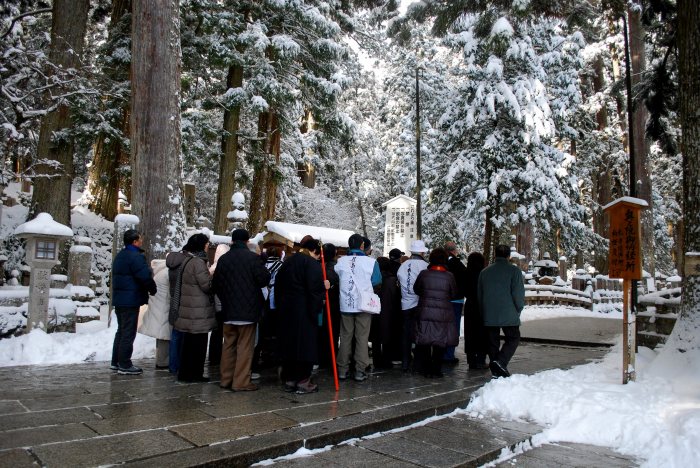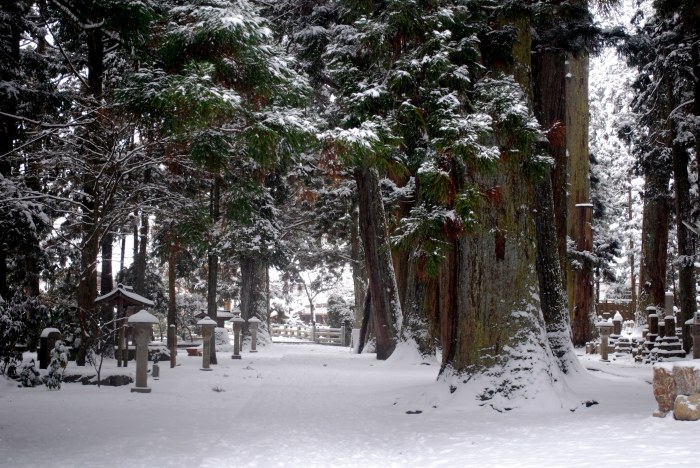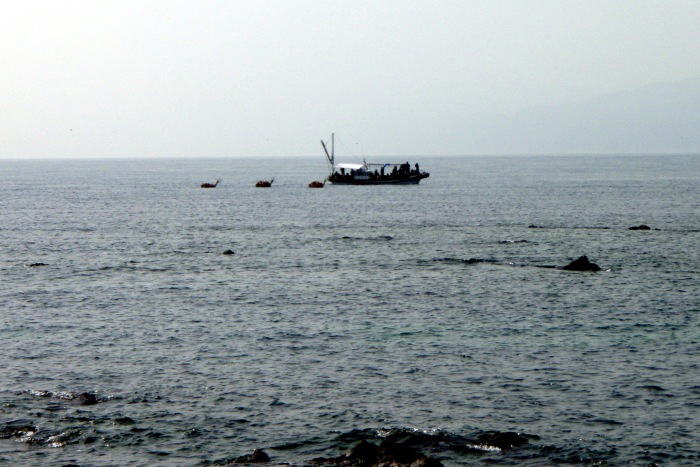What I love most about Japan, (or at least second most after takoyaki), is walking along and randomly discovering a shrine or temple, like tiny, high gable-roofed Shinto shrines placed in carved nooks along a highway, and red-knit covered ojizou statues in the corner of a rice-field or the larger, but somehow equally well hidden temples, in quiet zones between school yards with massive trunked trees shielding from the concrete city metres away.
Wakayama is a treasure vault of unimaginably old, awesome, historically significant and culturally interesting temples and shrines. What it lacks compared with Kyoto is maybe having them all within an easy walking/busing distance.
But the true must-see of this 10 Reasons list, the ultimate zone of zen and favourite resting place of Sengoku samurai warlords and 80s bubble era CEOs is Koyasan.
Koyasan
A sprawling, mountaintop Buddhist conclave, founded by Kukai about 1200 years ago, and rightly given World Heritage status in 2004, Koyasan has the most amazingly serene atmosphere. It is rarely thronging with tourists, but also isn’t a museum exhibit, but still a living, learning community of monks.
It is said, I think in Lonely Planet, to be particularly popular in summer, when it is a cool haven above the tropical, steamer that the rest of the prefecture becomes. I personally think that autumn is when it is most beautiful; the bright yellow, orange and crimson leaves as the perfect backdrop for a street of vermilion, spired temples. Unfortunately, my 5 year old, pre-DSLR photos won’t do it justice.
Winter is also a highly recommended time to visit.
The snow, while exhausting to walk through, deepens the mystical ambiance. The cemetery and the half buried grave stones seem other-worldly, like something from Mononoke no Hime; sliding along treacherously slippery stone walkways, as the silent, giant trees drop snowdrifts unexpectedly about you, the only colour bright, oversaturated ojizou statues in their red-knitted hats and bibs.
We played celebrity samurai cemetery spotting, finding the resting places of two of the civil-war Sengoku era’s famous warlords, Nobunaga and Hideyoshi.

Though he died while on campaign in Korea, this is where Hideyoshi, one of the great warlords of the Sengoku era, now lies

Nobunaga's grave is a little smaller and less 'off-limits' than Hideyoshi's. But considering how he used a the stones from a few Buddhist temples to build his fortresses, I guess he's lucky to be here at all
Note: Ieyasu Tokugawa, the ultimate Sengoku shogun, has a grave all to himself up in Nikko.
Weary pilgrims following Kukai’s footsteps around the island of Shikoku and up the ancient Kumano Kodo, finish their journey here, winding their way through a giant graveyard to a large temple where, it is said, the monk himself lives eternally.

A group of weary (well, maybe they came by bus), cold pilgrims wait to be shepherded through to Kukai's resting place

Believers pray to various Kanon near the entrance to Kukai's final resting place - a no camera's allowed zone
Koyasan is a popular burial spot for more than samurai and monks however, with big companies like Panasonic, Yakult and UCC Coffee establishing gravestones here as memorials to those who died from overwork in their service (not true, don’t quote me).
From Wakayama city, Koyasan is a decent train ride, so it’s best to leave early in the day and maybe consider one of the highly recommended temple stays overnight.
This website has a list of train directions including from Osaka and Wakayama.
Awashima Jinja
Awashima jinja is a place I keep coming back to.
The shrine is a storing house for dolls and avatars of gods and spirits, including the animals in the Chinese zodiac, Daruma, Maneki Neko, the 7 lucky gods, Kitsune foxes, Noh masks and hundreds and hundreds of Hina dolls.
A lot of people, Japanese especially, feel the atmosphere, being surrounded by hundreds, if not thousands of dolls is creepy. Though I have yet to see them, there is also apparently an underground room containing cursed dolls. One of which has hair that still grows…
I personally don’t find the atmosphere particularly spooky, but interesting and beautiful. I love exploring the collection, marveling at its variety and age. There is always some new detail to uncover here.
According to Wikipedia, there are many Awashima shrines in Japan, but Wakayama’s has the longest history. According to legend, the same Empress who dedicated the Niutsuhime temple, was caught in a storm near the Wakayama coast on her way back from invading Korea. Her prayers for deliverance answered, she enshrined a treasure here as thanks.
The reason for the mountain of dolls collected here is the belief they carry a soul and can only be safely disposed of through a ceremony. Most of the ceramic pieces remain, slowly encroaching into every space within the grounds, but the Hina dolls are taken out in boats on girl’s day, Hina Matsuri, blessed and then ceremonially burnt.
- A wall of Hina dolls
The festival takes place on March 3rd.
Awashima jinja is also considered a place to pray for fertility and protection against women’s diseases. The stacked ema boards relay hopes of healthy babies and easy deliveries, and little plastic bags, containing children’s underwear, are pegged alongside for the gods to consider. Elsewhere, within a shadowy, grate covered cave lurk a collection of unrealistically sized, wooden phalluses.
The Wakayama tourist organisation has directions on how to get there by train and a short walk.
Though at opposite ends of the prefecture from each other, Koyasan and Awashima jinja are iconic and memorable, and should be squeezed into any itinerary. Despite having seasonal perks, both are worth visiting at any time of the year.
Part 3 will focus more on closer attractions within Wakayama city itself.
















Wow, beautiful! Thanks for sharing those photos and the stories behind them. Japan is one of those places I’d love to see but feel like I’ll probably never visit because I’m too petrified to travel in places where I can’t speak the language. 😀 I have a friend who taught English there for awhile though and she absolutely loved it… I’m always amazed at people who can just muddle their way through when they can’t understand anybody! 😀
LikeLike
Thanks ^^ Japan is a surprisingly easy country to travel in without any Japanese ability. Signs are written in English, and tourist information stands have English speaking staff and maps. Hope you come over one day!
LikeLike
Reblogged this on travelwyse.
LikeLike
Pingback: 10 Reasons to add Wakayama to your Japan trip: Part 3: Wakayama city « Where Next Japan
I love this post, I love Japan, and the culture is so rich, it’s hard not to appreciate it. Puzzling rocket grave, would love to know what that is about. There is so much to learn about this culture I’m surprised everyday.
LikeLike
Thanks for your comment Elaine. A quick google didn’t reveal much about the rocket grave. Thus Japan protects its mystique 😉
LikeLike
Hmm,…interesting..that sounds like a great start to a fiction character. Hehe. Can’t wait to read more about your travels, I’m a Japan fanatic, so you’re like a god to me right now. Keep it up and safe travels.
LikeLike
Your pictures are amazing! Do you have any tips for taking pictures in Japan? I want to save up and buy a nice camera when I’m over there!
LikeLike
Thank you ^^ Probably just 2: Always have your camera with you and take lots of pictures. Sometimes the best pictures are the random ones ^^
LikeLike
OK! Now I have to go back and visit again as I missed all this! I opted for the sideroads and didn’t go to Koyasan. I really enjoyed your pictures and commentary. Where should I go for my next trip ? Can you recommend another area in Japan?
LikeLike
Sideroads can be good! Did you do the Kumano Kodo (the old pilgrimage route). Koyasan though is a must ^^
Hasedera in Nara prefecture is a beautiful temple surrounded by streets of food vendors (big, photogenic vats of green and black dried beans), or the ruins of Takada castle in Hyogo prefecture which have a Mayan atmosphere. If you ever come to Hikone, send me a message and I’ll show you around ^^
LikeLike
I love Wakayama too!
LikeLike
Wakayama is my favourite part of Japan ^^ Onsens, Koyasan, festivals, friendly people – what more can you ask for? ^^
LikeLike